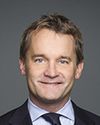Good morning, Madam Chair and honourable members.
I have the honour and privilege of serving as the president and CEO of the Canadian Museum of Nature.
I am very pleased to be here with you this morning to update you on the activities of the Canadian Museum of Nature.
We're one of Canada's six national museums that together cover art, history, science, innovation, immigration, human rights, and nature. As national museums, we believe that we reflect what Canadians value and that we tell our country's story. Over 150 years ago, the Geological Survey of Canada sent researchers out to map and record Canada's natural wealth. This work became the foundation of the Canadian Museum of Nature. We opened Canada's first national purpose-built museum in 1912 at the Victoria Memorial Museum Building on McLeod Street. We are still there today, with galleries inspired by, and specimens from, the survey's early efforts. Who knew that eventually we would convert that building into a nightclub?
Our reach extends nationally. We maintain nine active full-size travelling exhibitions, nine suitcase exhibits, which have smaller interactive items in displays, and four digital exhibits. These temporary exhibits reach one million visitors each year. In addition to engaging Canadians, our museum has a strong scientific mission. Our team of 24 scientists, paleontologists, botanists, mineralogists, and zoologists go into the field every year to collect and catalogue our environment. Their discoveries form the national natural history collection, a scientific collection of more than 10.5 million specimens. The most important pieces are made accessible to Canadians through our public engagement programs and travelling exhibits.
Through our memberships in key international bodies, for example, the Global Biodiversity Information Facility, Canadian data collected by our museum can be used by researchers around the world to understand and benchmark the state of biodiversity, to look at our Arctic, and to enable an understanding of how climate change is affecting our world. In fact, in 2015-16 our digitized data was downloaded 100 million times from the global biodiversity database. From a scientific point of view, this work is more critical than ever, given the global imperative to address climate change and biodiversity loss.
To support our work in 2012, we launched a new approach to operations focused on business sustainability. At that time, almost 90% of our revenue came from the federal government. We needed to increase revenues from museum admissions, pursue innovative sponsorships and partnerships, sustain our scientific knowledge and leadership, and enable more cost-effective operations.
In 2014-15, our combined revenues stood at $42.5 million. Earned revenue accounted for 21% and 79% came from government appropriations. Contributions, sponsorships, and annual giving stood at $2.8 million, a significant increase over the previous years, and we welcomed over 400,000 visitors. This past year we had over 480,000 visitors on site, and we reached an additional million visitors through our travelling exhibits across Canada and around the world.
I want to give you a sneak peek of this past year. Over $6.1 million in value was committed to the life and future of the museum through cash collections and in-kind contributions. I must point out that about $3 million of that was media sponsorship from The Globe and Mail.
Some 230 volunteers give their time and talent to help support the mission and mandate of the institution. Our researchers spent 170 days in the field across Canada and around the globe, advancing our role as a creator of knowledge about the natural world and furthering our research. Our scientists place a high value on their days in the field. They share what they find through over 90 publications, ensuring that our knowledge of plants, animals, fossils, and minerals inspires understanding and respect for nature.
On the programming side, we brought many innovative exhibits and programs—from Creatures of Light, about the nature of bioluminescence, to Animal Inside Out. More recently, it was all about bugs, live and otherwise—the ones we wanted in the building, not the ones we didn't want.
I have to tell you about Nature Nocturne. Now in its third year, it continues to sell out almost every time. I say “almost” because for the last one we had 20 tickets available at the last minute. This is a novel concept to engage young professionals—we call them “adult visitors”. Nature Nocturne opens at the museum at night and it marries our science and exhibits in a very informal atmosphere—two dance floors, nine bars. The first two hours they're in the galleries, the last two hours they're engaged with one another.
Where has all of this innovation taken us? Today, we're a museum of international first rank, a trusted source of understanding, providing evidence-based insights, and inspiring experiences and real engagement with nature's past, present, and future.



